Beef Prices
Beef prices could begin to firm up in the coming months, Quality Meat Scotland (QMS) has forecasted, in welcome news for cattle farmers, who have faced falling prices during the first part of the year.
Stuart Ashworth, head of economics services with QMS, said the supply and demand pendulum would soon start to swing back towards farmers as availability of prime cattle in the UK started to diminish in the next quarter.

“We expect to see the volume of cattle arriving at abattoirs slow down. It is likely we will then see some firmness in the market for the beef producer,” Ashworth predicted.
Ashworth said a range of factors had led to falling prices at the start of the year, all based around supply and demand. The volume of beef produced over the first quarter increased 1%, due to cattle being slaughtered at heavier weights. In addition, the strong pound has meant imports have become attractive, and exporting has become more expensive.
“Add to that the increase in domestic supply and we find that the market has been working with around 8% more beef than a year ago,” said Ashworth.
That would not have been an issue if consumption had been strong, but while it has improved for some cuts, it has not been enough to absorb the extra supply.
“Some cuts have been selling better than others, but the product which is not selling well has been building up in processors’ chills and has had to find a market in the manufacturing trade, which has been proving sluggish,” added Ashworth.
“This explains why we have seen a slide in farm-gate prices and why some of our producers have been facing an extended period to get cattle to market.”
However, looking forward he said the outlook was looking more promising for beef farmers.
“We know from the British Cattle Movement Service (BCMS) data that the volume of cattle set to come forward as prime stock over the next six to nine months will diminish further and the same scenario is expected in Ireland,” said Ashworth. “This will mean the abattoirs will be able to manage the sale of less popular cuts out of their cold stores and the whole supply and demand balance will come closer together.”
UK beef prices are coming under pressure from a range of factors, experts in Scotland have claimed.
According to Quality Meat Scotland (QMS), a number of issues, including currency exchange rates, were impacting on the beef sector, with the strong sterling increasing the gap between Irish and European prices.
Stuart Ashworth, head of economic services with QMS, said: “Despite Irish producers getting 6% more euros from the market than last year, the UK price is 13.5% higher in euros, so the gap has widened. However, because of currency movements, while the UK price is around 2-3% lower in sterling, Irish prices have fallen by 7-8%.”

Latest statistics from January show UK beef exports declining, while imports, including Irish meat, increased, boosting beef volumes on the UK market.
“While some of this would have been used to refill the supply chain after good Christmas trade, once the supply chain was fully restocked, pressure was exerted on prices from a well-supplied market,” Ashworth said.
While prices started the year looking positive, prime cattle values have fallen in the past six weeks, with the average price around 2-3% lower than a year ago, and the number of cattle being slaughtered tightening.
He added: “During February, Scottish abattoirs handled 3.8% fewer prime cattle than last year, compared with Northern Ireland at 2.5% fewer and England and Wales at 2% more.
“However, a bigger influence here is that carcase weights continue to be higher than last year, by around 1.5%. The result is that, despite the number of animals beginning to tighten, the volume of beef they produce is continuing to run ahead of last year.”
Another problem for the sector has been the slowdown in demand for manufacturing beef, which has impacted on the value of forequarter meat in the wholesale markets.